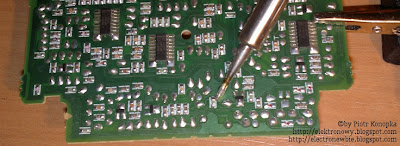Soldering is a process, method of joining permanently metal objects with help of filler metal (called solder) - other metal or metals alloy heated above its melting temperature, lower than melting temperature of metals being connected. In electric and electronics uses usually those are alloys in which major part is tin (Sn), hence they often are commonly simply referred to as 'tin'.
During soldering, besides normal so called wetting - meaning very good adhesion and filling small cracks and fissures - of surfaces being soldered, there is a process of diffusion of solder into soldered surfaces - atoms of solder flow into structure of soldered surface and atoms from soldered surface partially flow into the solder.
Thanks to that very good mechanical strength, good electric and thermal conductivity are achieved.
 |
| Joint 'glued' with solder with too low temperature used vs a correctly soldered joint. |
Simple adhesion or 'gluing' pieces together without diffusion results in a much weaker connection - mechanical, electric and thermal, which is one of soldering errors being effect of surfaces not being heated well enough. I'll write more about soldering errors in next part about soldering techniques and frequent errors.
This method is different from welding in that the filler metal used is the only element joining surfaces being soldered, while in welding temperature is high enough to also melt edges of welded pieces to connect them stronger (at the same time in obvious way partially damaging welded surfaces).
This article mainly refers to soldering in electronics, partially in general in electrics, only with mention of other areas.
So if you want to solder stained glass, pipes or gutters - of course I invite you to read further, maybe you'll learn something interesting, however not having any experience with soldering gutters, pipes or stained glass I can't vouch for this knowledge being useful for you in what you're interested in. I am confident that there are many pages in the internet dedicated to other uses of this technique - the topic of this blog however probably doesn't include them ;)
How to begin?
Soldering is a fundamental skill which you need to obtain to be able to deal with electronics (and electrics).
As with most skills - there are some tools you need to have to be able to perform it.
Knowledge of some rules, theory is needed to not stumble around blindly and to not make simplest and at the same time most common errors which cause a failure and in effect often discourage in the very beginning.
And at last training is needed, without which everything will be just dry and moderately interesting theory. And even knowing theory very well, without practice in the beginning you probably won't be soldering ideally until you get your hand used to doing it - you won't be accustomed to it, you won't learn your own techniques and reflexes which will perform best just for you.
Thanks to all that theory however you will know where to begin from, you'll avoid some blisters and worse damage, you'll avoid destroyed electronic elements and burnt circuit boards, you'll avoid destroyed soldering iron tips thanks to which you'll avoid a lot of nerves, so if you consider avoiding those problems a worthy enterprise - I invite you to read further, as I'll carry on to the topic now ;)
Next part: 2.1. Soldering - Basics - Which soldering tool?
Previous part (and beginning): 1. Safety rules and hazards in electrics and electronics

No comments:
Post a Comment